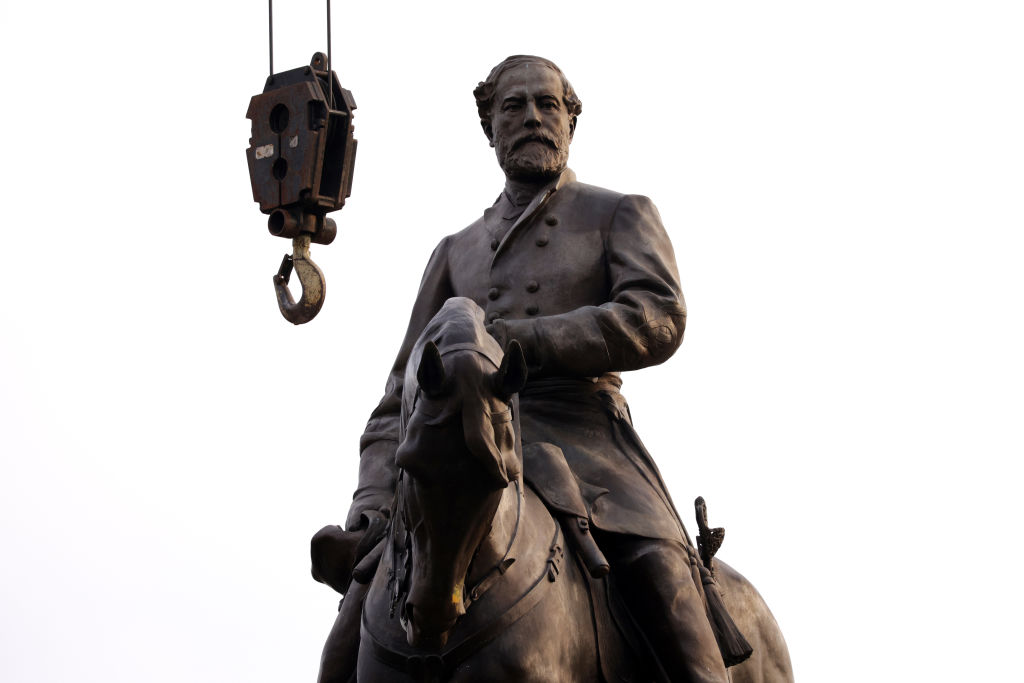
Donald Trump has been in full Messiah-mode lately, telling his followers that he’s suffering for their sake, sharing a faux courtroom sketch of Christ at his side, and circulating actor Jon Voight’s bizarre claim that he is being “destroyed as Jesus.”
The last time America’s political scene witnessed such heavy Christ-comparisons was in the immediate aftermath of the Civil War, when Unionists and Confederates both deified their heroes. This practice had ominous consequences, including the perpetuation of a violent white supremacist ideology in the South. This Easter it’s important to remember why analogies to Jesus should stay out of the political realm. The results are always ugly.
In the wake of Lincoln’s assassination on Good Friday, 1865, grieving Unionists, from politicians to faith leaders, began comparing the fallen president to Jesus. Within five hours of the shooting, James Garfield — who would become America’s second assassinated president 16 years later — told a Manhattan crowd: "It may be almost impious to say it, but it does seem that Lincoln's death parallels that of the Son of God."
Ministers across America echoed the sentiment. “Heaven rejoices this Easter morning in the resurrection of our lost leader,” the Reverend Henry W. Bellows declared on Easter Sunday. In paintings, etchings, and cameos, Lincoln was depicted as the nation’s Savior.
Inevitably, this reverence produced a backlash in the South. Before the Civil War, Southerners were already enraged by Northern comparisons of the radical abolitionist John Brown to Jesus. In October of 1859, when Brown was awaiting execution, Henry David Thoreau delivered a speech in Concord, Mass., in which he declared that: “Some eighteen hundred years ago, Christ was crucified; this morning, perchance, Captain Brown was hung....He is not old Brown any longer; he is an angel of light.”
The apotheosis of an anti-slavery zealot like Brown was bad enough, but when Lincoln replaced him as the Christlike martyr, Confederates boiled over. Southern anger about Lincoln and the war he presided over was still too raw. One Kentucky editorialist denounced the late president as “head centre of a hot bed of thieves, knaves, cowards, plunderers, murderers, houseburners, woman murderers, spoon thieves.”
Read More: The Blasphemy of Comparing Trump to Jesus Christ
In 1866, Edward Pollard, the editor of the Richmond Examiner who launched the Lost Cause mythology—which glorified the Confederacy and its fight—bitterly attacked the North’s deification of “the Illinois Ape.” He opened chapter six of The Lost Cause: A New Southern History of the War of the Confederates, by lamenting that “A large portion of the Northern people have a custom of apotheosis.”
This characterization of apotheosis as a Northern phenomenon was a curious move, since Northerners and Southerners alike had spent 60 years deifying George Washington. But when Unionists combined Washington and Lincoln as "Father and Saviour of the Nation," Pollard snapped. Idolatry, the editor claimed, was a Yankee sin, typical of a people whose fanatical Puritan ancestors had revered their leaders as “saints.” To Pollard, the “contrast between the Northern and Southern minds” was evident in their different approach to “worship of that great American idol—the Union.” Throughout his book, Pollard condemned what he saw as excessive worship of the Constitution, the Union, Brown, Ulysses S. Grant, and above all—Lincoln. Southerners, he insisted, were more measured in their enthusiasms.
In the coming years the South proved him wrong.
With Northerners and their allies embracing Lincoln as the Union’s savior, Southerners searched for their own messiah. First they honored the incarcerated Confederate President Jefferson Davis as a martyr. During his postwar imprisonment in Fortress Monroe, Davis’ wife, Varina, wove her husband a crown of thorns, while Southern ministers referred to his chains as “the martyr ring.”
Some Southern ministers went so far as to encourage all Confederate veterans to compare themselves to Christ. In Baptized in Blood, historian Charles Reagan Wilson chronicles how “Carter Helm Jones of Louisville reminded his audience of war veterans of ‘the memories of your Gethsemane’ and ‘the agonies of your Golgotha.’”
Robert E. Lee, however, got the fullest Jesus-treatment. After his death in 1870, Lee’s fans were quick to make the comparison. Joseph B. Kershaw, a Confederate general from South Carolina, wrote a commemoration reprinted in multiple Southern papers in which he praised Lee’s form, face and bearing as “god-like in beauty, power and grace,” before asking: “what was his life for the last five years but a constant martyrdom of the spirit—daily dying for us.”
Virginia state senator John Daniel, a rising political star, picked up the ball at the 1883 dedication of the Recumbent Lee monument at Washington and Lee University. Daniel delivered a three-hour speech in which he compared Lee’s tormented decision over whether to join the Confederacy, and his subsequent years of fighting, to “the agony of and bloody sweat of Gethsemane and to the Cross of Calvary beyond.”
This comparison persisted for decades. In 1904, a writer in the Charlotte Observer mused “Since the Christ-man walked the waters of blue Galilee, no man has been as nearly his counterpart as this hero of our Southland, Robert E. Lee.” And in 1917, the Reverend Randolph McKim wrote that Lee’s sufferings had “pressed sorely upon him, a true crown of thorns.”
The sense of Lee as a Southern Jesus is one reason why the landscape south of the Mason-Dixon line is still filled with Lee memorials. Southerners erected Confederate monuments in the late 19th and early 20th centuries to enforce racial hierarchies, but in Lee’s case they also provided a counterpoint to Lincoln idolatry. North and South, each culture dedicated hundreds of memorials to its favorite demigod.
In 1922, when Lincoln was "enshrined" in his enormous "temple" on the National Mall, the United Daughters of the Confederacy tried to counter with a huge carving of Lee at Stone Mountain, Ga., unveiled two years later. Their effort floundered when the sculptor of the Lee carving, Gutzon Borglum, feuded with the UDC over finances and personality clashes and left to carve presidents, including Lincoln, at Mount Rushmore. Borglum’s Lee was later blasted off the mountain, making way for Henry Augustus Lukeman’s sculpture of Lee, Davis, and Stonewall Jackson.
Read More: Tim Alberta on What Fuels the Evangelical Devotion to Trump
In 1924, at the unveiling ceremony for Borglum’s short-lived Lee, Plato Durham—former dean at Emory University—gave an address in which he, too, deified the general. This time Lee was described not as the Son of God, but as a Roman sun god: “Oh Mountain, speak your message well…When the rain of heaven beats upon your majestic face, let all men say ‘Lee is weeping for the sorrows of a people.’ When the sun of morning strikes along your altitudes, let mankind behold a newer Sol Invictus and exclaim ‘The Invincible Light.’”

The deification of Lee had deadly consequences. Memorials to the general depicted him in uniform, exalting the Confederate cause and its faith in white supremacy—what W.E.B. Du Bois called “the religion of whiteness.” By honoring Lee as a martyr to a noble cause, Southerners could resist looking inward and reconsidering the truth about slavery and the Civil War. Instead, with Lee as their idol, Southern believers in whiteness unleashed a century of violence: from the white knights of the Ku Klux Klan, burning crosses and murdering Black Americans, to the white supremacists in Charlottesville, Va. in 2017, who came to rally round a statue of Lee, wielding torches and running down pedestrians.
Donald Trump responded to the violence in Charlottesville by saying that there were “very fine people” on both sides. And now that he is the Christlike martyr—whose faithful followers proved willing, on Jan. 6, 2021, to storm the Capitol, attack police officers, and threaten to hang then-vice president Mike Pence—Americans are left to wonder what further violence might emerge from such twisted faith.
Laura Brodie teaches at Washington and Lee University. She is author of numerous books, including. Breaking Out: VMI and the Coming of Women.
Made by History takes readers beyond the headlines with articles written and edited by professional historians. Learn more about Made by History at TIME here. Opinions expressed do not necessarily reflect the views of TIME editors.
More Must-Reads From TIME
- The 100 Most Influential People of 2024
- Coco Gauff Is Playing for Herself Now
- Scenes From Pro-Palestinian Encampments Across U.S. Universities
- 6 Compliments That Land Every Time
- If You're Dating Right Now , You're Brave: Column
- The AI That Could Heal a Divided Internet
- Fallout Is a Brilliant Model for the Future of Video Game Adaptations
- Want Weekly Recs on What to Watch, Read, and More? Sign Up for Worth Your Time
Write to Laura Brodie / Made by History at madebyhistory@time.com
